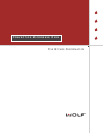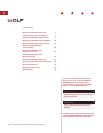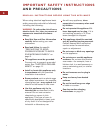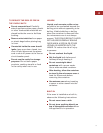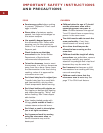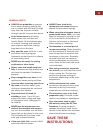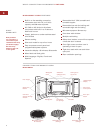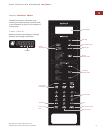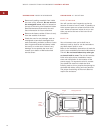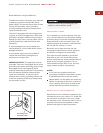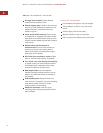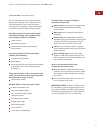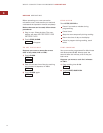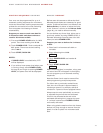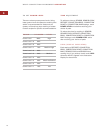
6
IMPORTANT SAFETY INSTRUCTIONS
AND PRECAUTIONS
CHILDREN
Children below the age of 7 should
use the microwave oven with a
supervising person very near to
them. Children between the ages of
7 and 12 should have a supervising
person in the same room.
The child must be able to reach the
oven comfortably; if not, they
should stand on a sturdy stool.
At no time should anyone be
allowed to lean or swing on the
oven door.
Children should be taught all safety
precautions: use potholders, remove
coverings carefully, pay special
attention to packages that crisp food
because they may be extra hot.
Don’t assume that because a child
has mastered one cooking skill they
can cook everything.
Children need to learn that the
microwave oven is not a toy. See
page 17 for Child Lock feature.
FOOD
Puncture egg yolks before cooking
to prevent “explosion”. Don’t cook
eggs in shells.
Pierce skins of potatoes, apples,
squash, hot dogs and sausages so
that steam escapes.
Use specially bagged popcorn for
the microwave oven. Listen while
popping corn for the popping to
slow to 1 or 2 seconds or use special
Popcorn pad.
Check foods to see that they
are cooked to the United States
Department of Agriculture’s
recommended temperatures.
To test for doneness, insert a meat
thermometer in a thick or dense area
away from fat or bone. Never leave
the thermometer in the food during
cooking, unless it is approved for
microwave oven use.
Don’t heat baby food in original jars.
Transfer baby food to a small dish
and heat carefully, stirring often.
Check temperature before serving.
Don’t heat bottles with nipples on.
Put nipples on bottles after heating
and shake thoroughly. “Wrist” test
before feeding. Don’t heat dispos-
able bottles.
After heating baked goods with
fillings, pierce outside of food to
release steam and avoid burns.
Don’t heat or cook in closed glass
jars or air tight containers.
Don’t preserve foods by canning
using the microwave oven, as
harmful bacteria may not be
destroyed.



